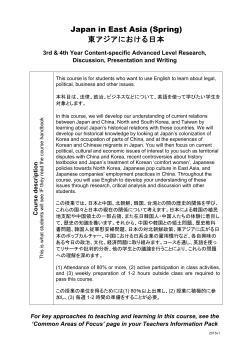
Japanese Natural Ecology ï¼»PDF 294KBï¼½
For students enrolled in 2015 K1117 Nature and the Environment in Japan For students enrolled in or before 2014 K0021 Japanese Natural Ecology 【NATURE & ENVIRONMENT】 【JPN NAT ECOL】 2 credits Spring 2015 2 credits Spring 2015 INSTRUCTOR: Norio YAMAMURA OFFICE: Mukokukan 606 (Kyotanabe Campus) TELEPHONE: 0774-65-7167 EMAIL: nyamamur@mail.doshisha.ac.jp OFFICE HOURS: by appointment Course Description This course introduces students to the natural environment of the Japan, focusing on the connection of human inhabitants to the ecology, natural resouces, and physical phenomena. Background topics such as the topography, climate, biodiversity, natural history, and geographic history of the Japanese islands are examined together with issues surrounding the various manifestations of interactions between humans, other living flora and fauna, and the non-living, including topics such as “satoyama”, river, wetland, coastal, and urban built environments, land management, nature conservation, and environmental movements. Students are encouraged to apply knowledge gained in class and assignments by actually exploring nature and the environment in the field (e.g., gardens, mountains, natural museums, etc). Course Objectives As a part of the “institute-wide courses” for understanding the natural environment of the Japan, which provide a broad spectrum of knowledge and experiences about the natural world, human cultures and societies, this course transcends preparation for specific careers. The objective of this class is to develop a better understanding of Japanese ecological nature using fundamental scientific knowledge about natural environment and biodiversity. Students should gain an appreciation for the complex relationship between nature and humans. Course Requirements and Assignments This course consists of conventional classroom lectures and observation of exhibition for Japanese nature at several places outside the campus. a) Attendance, Readings and Participation: You are required to attend the lectures and practice at Imadegawa with an attendance record of at least 80%. You are responsible for completing the readings (course materials) for the day they are assigned. You are also required to visit several places in Kyoto, such as Kyoto Botanical Garden, Kyoto Aquarium, and Arashiyama Monkey Park, for observation of exhibition for Japanese nature and human life. The schedule will be decided after classroom discussion and may be changed depending on weather. b) Observation and a short essay: You must be a keen observer of natural and social environments, keeping a careful note during the fieldwork. A short essay on the exhibition of the particular site will be assigned to you. For writing the paper, you should synthesize the general part of the lectures and the particular observations. At the end of the course you are required to take a summary essay on the Japanese nature that you have recognized. Evaluation Criteria & Grading Grading for the course will be determined as follows: 1. Attendance and participation 2. Field journal 3. Assignment and short essays 4. Final essay 50% 15% 15% 20% Additional Information: CLASSROOM POLICIES 1. Please come to class prepared and on time. Do not enter the classroom if you are late by more than 15 minutes. 2. Let me know if you have an emergency and will not be able to come to class. 3. Please turn off your mobile phones. It is inappropriate to go outside to make calls or to send or read text messages during class. 4. No sleeping in class. 5. You are responsible for the honest completion and representation of your work avoiding academic misconduct, such as plagiarism and cheating. Course Materials <Textbooks> Biodiversity of Japan A Harmonious Coexistence between Nature and Humankind Japan Wildlife Research Center, Heibonsha Ltd. 2010. ISBN: 978-0-13-713816-6 <Reference books, sources of readings and other information> The Futurabiliy of Biodiversity Educational presentation material for use in university lectures Research Institute for Humanity and Nature. 2010. CD-ROM Kyoto Prefecture Web Site Available at: http://www.pref.kyoto.jp/en/index.html Kyoto Aquarium Web Site Available at: http://www.kyoto-aquarium.com/en/index.html Arashiyama Monkey Park Web Site Available at: http://www.kmpi.co.jp/english/ Tenryu-ji-temple Web Site Available at: http://kyoto.travel/en/shrine_temple/170 Course Schedule Week 1 Introduction to the Japanese Archipelago Topic: Geology, Topography and Climate. Week 2 Introduction to the Japanese Archipelago Topic: Vegetation and Land Use Transition. Week 3 Ecosystems of Japan Topic: Natural mountain areas. Week 4 Ecosystems of Japan Topic: Satochi-Satoyama areas. Week 5 Ecosystems of Japan Topic: Urban areas. Week 6 Ecosystems of Japan Topic: River and lake areas. Week 7 Ecosystems of Japan Topic: Oceanic and Coastal areas. Week 8 Ecosystems of Japan Topic: Island areas. Week 9 Kyoto Botanical Garden – observation (on Saterday afternoon) Week 10 Kyoto Botanical Garden – discussion (on Saterday afternoon) Week 11 Kyoto Aquarium – observation (on Saterday afternoon) Week 12 Kyoto Aquarium – discussion (on Saterday afternoon) Week 13 Arashiyama Monkey Park – observation (on Saterday afternoon) Week 14 Tenryu-ji Temple – discussion (on Saterday afternoon) Week 15 Final discussion Note: This syllabus is subject to changes and/or revisions.
© Copyright 2025













